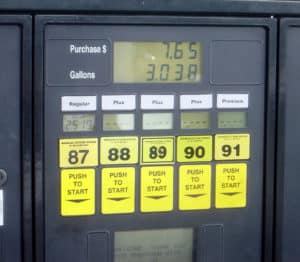
My wife drives a car that requires, by the manual, 93 octane gasoline. My car, on the other hand, requires only 87 octane gasoline. Recently, there was an occasion where I needed to fill my wife’s car and, just out of force of habit with my car, I mistakenly chose to use 87 octane. She became concerned that the car was going to be damaged. I wanted to put her mind at ease, so I did some research…
The consequences of a one-time mistake of a partial fill of a car that requires a higher octane with a lower octane fuel will be positively negligent if there is any at all to your engine. However, if this choice is repeated time and again, it could well cause serious and expensive problems in a car’s engine.
The more detailed explanation is thus: A car that is designed to use a higher octane fuel will compress the combined air and fuel mixture more so than a car that is designed to use a lower octane fuel. The fuel/air mixture of the lower octane fuel will not be able to withstand the extra pressure put upon it by the higher compression engine and will thereby combust (explode within the cylinders of the engine to propel your vehicle) too soon and cause the piston’s timing to be slightly off. In other words, the early ignition of the fuel/air mixture will place downward pressure on the still upward-moving piston in its attempt to further compress the fuel/air mixture. Often, in cars that have a more pronounced misfiring, as described, you will hear a knocking or pinging sound coming from your engine. To better explain, let me show you…
How an Internal Combustion Engine Works:

This image displays how most internal combustion engines function. What you see is a display of the four-stroke cycle in action. Your car engine has upwards of 4 of these and they are running alternately; while one piston moves up, the next piston will be moving down.
Step 1: the right tube (known as the intake valve) opens up while the piston simultaneously moves down. This brings a mixture of air and fuel (represented by blue) into the cylinder.
Step 2: the piston moves back up, compressing the air and fuel, thereby increasing the temperature and pressure in the cylinder.
Step 3: Step 3 is initiated by the firing of the spark plug (at the middle top portion of the image) igniting the fuel/air mixture into an enclosed explosion. Doing so releases the energy of the fuel downward forcing the piston and the piston rod against the driveshaft transferring the force of movement to your transmission moving the vehicle.
Step 4: Here the piston moves upward and forces the release of the spent fuel/air mixture out of the exhaust port.
This cycle repeats many times while your car is running.
As was stated above, there will be no measurable damage done to your car if you make one mistake. But, doing so regularly will cause damage to the pistons and cylinders by leaving a varnish on either or both. And that, if left to build up will ruin your engine over time.
If you find yourself still concerned after making such a mistake, there is a remedy. There are several octane boosters on the market. STP is the most well-known. But, there are many others. These products will boost your octane level and thereby keep your fuel mixture from firing at low compression and the consequences of piston and cylinder damage.
It is important to get a product that comes in a bottle with an extended neck. This allows you to push past the flap called a “rollover valve” (It supposedly keeps gas from flowing out during a rollover) when inserting the bottle into your car’s fuel port.
All this begs the question, What happens when mixing two different octane gas products?
According to Mike Allen, Senior Automotive Editor, Popular Mechanics magazine and Master Auto Technician who is quoted from Quora on the subject:
“If the two gasoline stocks are relatively close in octane, you’ll simply get a gas that performs like the average of the two. Some pumps that dispense mid-grade gasoline simply blend premium and regular.”.
What this means in my stated case of half of a tank of 93 octane fuel, now combined with the mistakenly added 87 octane, is that I now have the equivalent of 90 octane gasoline in my wife’s car.
Best of Health, Best of Luck.
Berk
Header photo By The original uploader was Bobak at English Wikipedia. – Transferred from en.wikipedia to Commons by Matt.T., CC BY-SA 2.5, https://commons.wikimedia.org/w/index.php?curid=9568528
